Long Li
ECBench: Can Multi-modal Foundation Models Understand the Egocentric World? A Holistic Embodied Cognition Benchmark
Jan 09, 2025



Abstract:The enhancement of generalization in robots by large vision-language models (LVLMs) is increasingly evident. Therefore, the embodied cognitive abilities of LVLMs based on egocentric videos are of great interest. However, current datasets for embodied video question answering lack comprehensive and systematic evaluation frameworks. Critical embodied cognitive issues, such as robotic self-cognition, dynamic scene perception, and hallucination, are rarely addressed. To tackle these challenges, we propose ECBench, a high-quality benchmark designed to systematically evaluate the embodied cognitive abilities of LVLMs. ECBench features a diverse range of scene video sources, open and varied question formats, and 30 dimensions of embodied cognition. To ensure quality, balance, and high visual dependence, ECBench uses class-independent meticulous human annotation and multi-round question screening strategies. Additionally, we introduce ECEval, a comprehensive evaluation system that ensures the fairness and rationality of the indicators. Utilizing ECBench, we conduct extensive evaluations of proprietary, open-source, and task-specific LVLMs. ECBench is pivotal in advancing the embodied cognitive capabilities of LVLMs, laying a solid foundation for developing reliable core models for embodied agents. All data and code are available at https://github.com/Rh-Dang/ECBench.
VideoRefer Suite: Advancing Spatial-Temporal Object Understanding with Video LLM
Jan 08, 2025Abstract:Video Large Language Models (Video LLMs) have recently exhibited remarkable capabilities in general video understanding. However, they mainly focus on holistic comprehension and struggle with capturing fine-grained spatial and temporal details. Besides, the lack of high-quality object-level video instruction data and a comprehensive benchmark further hinders their advancements. To tackle these challenges, we introduce the VideoRefer Suite to empower Video LLM for finer-level spatial-temporal video understanding, i.e., enabling perception and reasoning on any objects throughout the video. Specially, we thoroughly develop VideoRefer Suite across three essential aspects: dataset, model, and benchmark. Firstly, we introduce a multi-agent data engine to meticulously curate a large-scale, high-quality object-level video instruction dataset, termed VideoRefer-700K. Next, we present the VideoRefer model, which equips a versatile spatial-temporal object encoder to capture precise regional and sequential representations. Finally, we meticulously create a VideoRefer-Bench to comprehensively assess the spatial-temporal understanding capability of a Video LLM, evaluating it across various aspects. Extensive experiments and analyses demonstrate that our VideoRefer model not only achieves promising performance on video referring benchmarks but also facilitates general video understanding capabilities.
Chain of Ideas: Revolutionizing Research Via Novel Idea Development with LLM Agents
Oct 25, 2024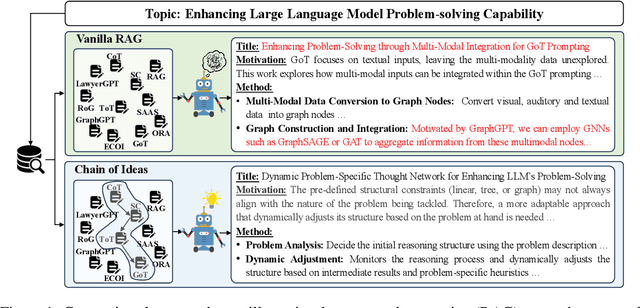

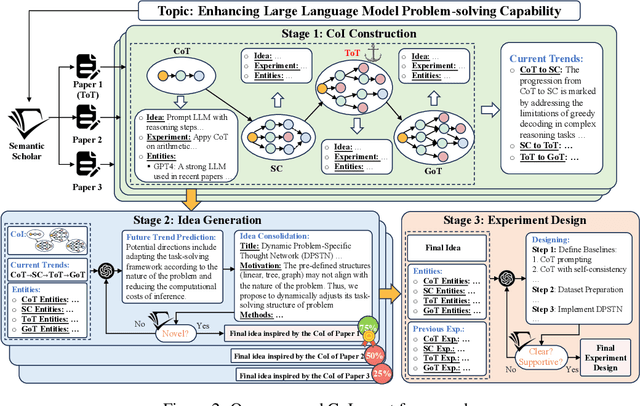

Abstract:Effective research ideation is a critical step for scientific research. However, the exponential increase in scientific literature makes it challenging for researchers to stay current with recent advances and identify meaningful research directions. Recent developments in large language models~(LLMs) suggest a promising avenue for automating the generation of novel research ideas. However, existing methods for idea generation either trivially prompt LLMs or directly expose LLMs to extensive literature without indicating useful information. Inspired by the research process of human researchers, we propose a Chain-of-Ideas~(CoI) agent, an LLM-based agent that organizes relevant literature in a chain structure to effectively mirror the progressive development in a research domain. This organization facilitates LLMs to capture the current advancements in research, thereby enhancing their ideation capabilities. Furthermore, we propose Idea Arena, an evaluation protocol that can comprehensively evaluate idea generation methods from different perspectives, aligning closely with the preferences of human researchers. Experimental results indicate that the CoI agent consistently outperforms other methods and shows comparable quality as humans in research idea generation. Moreover, our CoI agent is budget-friendly, with a minimum cost of \$0.50 to generate a candidate idea and its corresponding experimental design.
Chain of Ideas: Revolutionizing Research in Novel Idea Development with LLM Agents
Oct 17, 2024



Abstract:Effective research ideation is a critical step for scientific research. However, the exponential increase in scientific literature makes it challenging for researchers to stay current with recent advances and identify meaningful research directions. Recent developments in large language models~(LLMs) suggest a promising avenue for automating the generation of novel research ideas. However, existing methods for idea generation either trivially prompt LLMs or directly expose LLMs to extensive literature without indicating useful information. Inspired by the research process of human researchers, we propose a Chain-of-Ideas~(CoI) agent, an LLM-based agent that organizes relevant literature in a chain structure to effectively mirror the progressive development in a research domain. This organization facilitates LLMs to capture the current advancements in research, thereby enhancing their ideation capabilities. Furthermore, we propose Idea Arena, an evaluation protocol that can comprehensively evaluate idea generation methods from different perspectives, aligning closely with the preferences of human researchers. Experimental results indicate that the CoI agent consistently outperforms other methods and shows comparable quality as humans in research idea generation. Moreover, our CoI agent is budget-friendly, with a minimum cost of \$0.50 to generate a candidate idea and its corresponding experimental design.
CONDA: Condensed Deep Association Learning for Co-Salient Object Detection
Sep 04, 2024
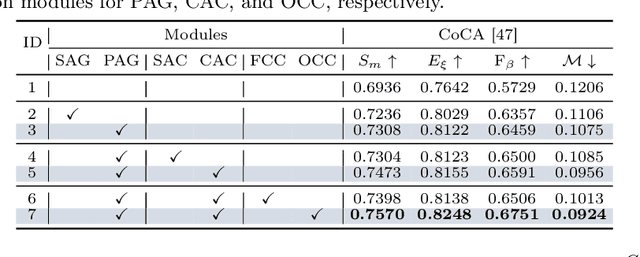
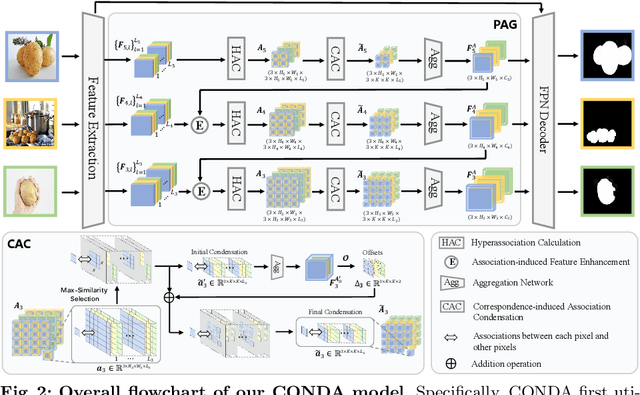
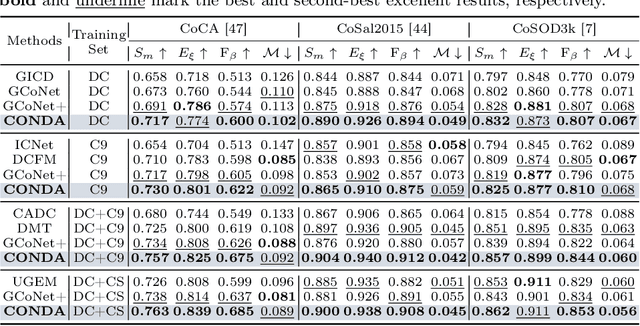
Abstract:Inter-image association modeling is crucial for co-salient object detection. Despite satisfactory performance, previous methods still have limitations on sufficient inter-image association modeling. Because most of them focus on image feature optimization under the guidance of heuristically calculated raw inter-image associations. They directly rely on raw associations which are not reliable in complex scenarios, and their image feature optimization approach is not explicit for inter-image association modeling. To alleviate these limitations, this paper proposes a deep association learning strategy that deploys deep networks on raw associations to explicitly transform them into deep association features. Specifically, we first create hyperassociations to collect dense pixel-pair-wise raw associations and then deploys deep aggregation networks on them. We design a progressive association generation module for this purpose with additional enhancement of the hyperassociation calculation. More importantly, we propose a correspondence-induced association condensation module that introduces a pretext task, i.e. semantic correspondence estimation, to condense the hyperassociations for computational burden reduction and noise elimination. We also design an object-aware cycle consistency loss for high-quality correspondence estimations. Experimental results in three benchmark datasets demonstrate the remarkable effectiveness of our proposed method with various training settings.
* There is an error. In Sec 4.1, the number of images in some dataset is incorrect and needs to be revised
Symbolic Learning Enables Self-Evolving Agents
Jun 26, 2024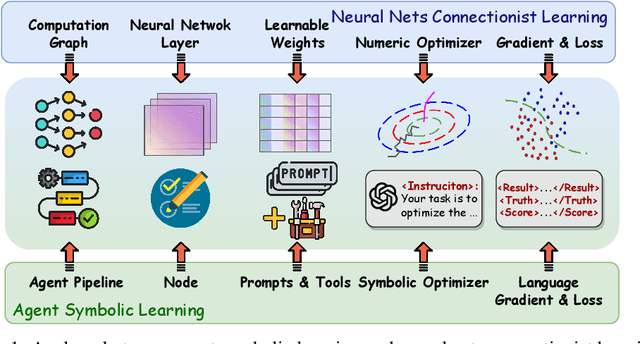

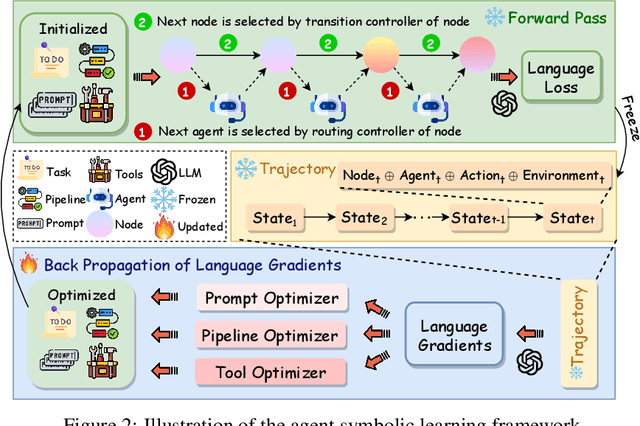

Abstract:The AI community has been exploring a pathway to artificial general intelligence (AGI) by developing "language agents", which are complex large language models (LLMs) pipelines involving both prompting techniques and tool usage methods. While language agents have demonstrated impressive capabilities for many real-world tasks, a fundamental limitation of current language agents research is that they are model-centric, or engineering-centric. That's to say, the progress on prompts, tools, and pipelines of language agents requires substantial manual engineering efforts from human experts rather than automatically learning from data. We believe the transition from model-centric, or engineering-centric, to data-centric, i.e., the ability of language agents to autonomously learn and evolve in environments, is the key for them to possibly achieve AGI. In this work, we introduce agent symbolic learning, a systematic framework that enables language agents to optimize themselves on their own in a data-centric way using symbolic optimizers. Specifically, we consider agents as symbolic networks where learnable weights are defined by prompts, tools, and the way they are stacked together. Agent symbolic learning is designed to optimize the symbolic network within language agents by mimicking two fundamental algorithms in connectionist learning: back-propagation and gradient descent. Instead of dealing with numeric weights, agent symbolic learning works with natural language simulacrums of weights, loss, and gradients. We conduct proof-of-concept experiments on both standard benchmarks and complex real-world tasks and show that agent symbolic learning enables language agents to update themselves after being created and deployed in the wild, resulting in "self-evolving agents".
Unveiling the Impact of Multi-Modal Interactions on User Engagement: A Comprehensive Evaluation in AI-driven Conversations
Jun 21, 2024Abstract:Large Language Models (LLMs) have significantly advanced user-bot interactions, enabling more complex and coherent dialogues. However, the prevalent text-only modality might not fully exploit the potential for effective user engagement. This paper explores the impact of multi-modal interactions, which incorporate images and audio alongside text, on user engagement in chatbot conversations. We conduct a comprehensive analysis using a diverse set of chatbots and real-user interaction data, employing metrics such as retention rate and conversation length to evaluate user engagement. Our findings reveal a significant enhancement in user engagement with multi-modal interactions compared to text-only dialogues. Notably, the incorporation of a third modality significantly amplifies engagement beyond the benefits observed with just two modalities. These results suggest that multi-modal interactions optimize cognitive processing and facilitate richer information comprehension. This study underscores the importance of multi-modality in chatbot design, offering valuable insights for creating more engaging and immersive AI communication experiences and informing the broader AI community about the benefits of multi-modal interactions in enhancing user engagement.
How Do Humans Write Code? Large Models Do It the Same Way Too
Feb 24, 2024Abstract:Large Language Models (LLMs) often make errors when performing numerical calculations. In contrast to traditional chain-of-thought reasoning, the program-of-thoughts approach involves generating executable code to solve problems. By executing this code, it achieves more precise results. Using generated executable code instead of natural language can reduce computational errors. However, we observe that when LLMs solve mathematical problems using code, they tend to generate more incorrect reasoning than when using natural language. To address this issue, we propose Human-Think Language (HTL), a straightforward yet highly efficient approach inspired by human coding practices. The approach first generates problem-solving methods described in the natural language by the model, then converts them into code, mirroring the process where people think through the logic in natural language before writing it as code. Additionally, it utilizes the Proximal Policy Optimization (PPO) algorithm, enabling it to provide feedback to itself based on the correctness of mathematical answers, much like humans do. Finally, we introduce a focus-attention mechanism that masks the question segment, enhancing its reliance on natural language inference solutions during code generation. We conduct our experiments without introducing any additional information, and the results across five mathematical calculation datasets showcase the effectiveness of our approach. Notably, on the NumGLUE dataset, the LlaMA-2-7B-based model achieves a superior performance rate (75.1%) compared to the previous best performance with the LlaMA-2-70B model (74.4%).
Weaver: Foundation Models for Creative Writing
Jan 30, 2024

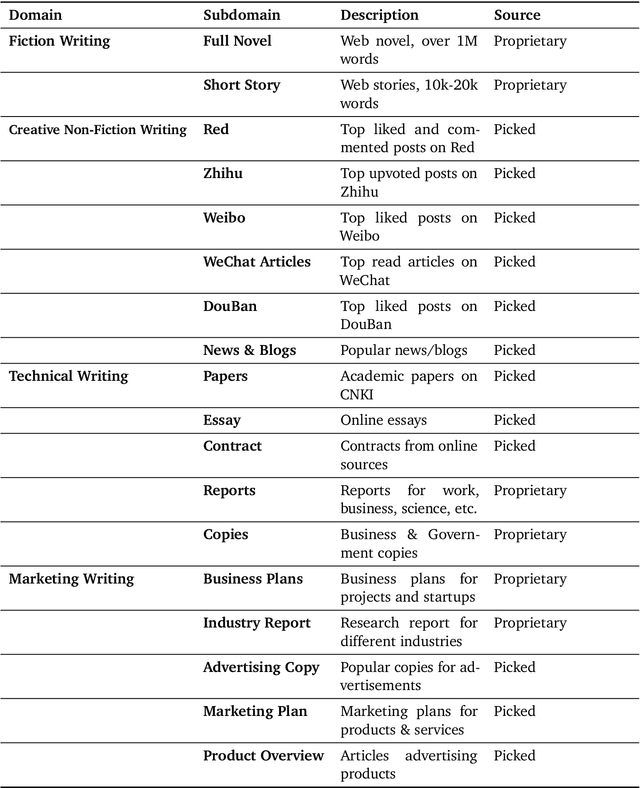

Abstract:This work introduces Weaver, our first family of large language models (LLMs) dedicated to content creation. Weaver is pre-trained on a carefully selected corpus that focuses on improving the writing capabilities of large language models. We then fine-tune Weaver for creative and professional writing purposes and align it to the preference of professional writers using a suit of novel methods for instruction data synthesis and LLM alignment, making it able to produce more human-like texts and follow more diverse instructions for content creation. The Weaver family consists of models of Weaver Mini (1.8B), Weaver Base (6B), Weaver Pro (14B), and Weaver Ultra (34B) sizes, suitable for different applications and can be dynamically dispatched by a routing agent according to query complexity to balance response quality and computation cost. Evaluation on a carefully curated benchmark for assessing the writing capabilities of LLMs shows Weaver models of all sizes outperform generalist LLMs several times larger than them. Notably, our most-capable Weaver Ultra model surpasses GPT-4, a state-of-the-art generalist LLM, on various writing scenarios, demonstrating the advantage of training specialized LLMs for writing purposes. Moreover, Weaver natively supports retrieval-augmented generation (RAG) and function calling (tool usage). We present various use cases of these abilities for improving AI-assisted writing systems, including integration of external knowledge bases, tools, or APIs, and providing personalized writing assistance. Furthermore, we discuss and summarize a guideline and best practices for pre-training and fine-tuning domain-specific LLMs.
Agents: An Open-source Framework for Autonomous Language Agents
Sep 14, 2023Abstract:Recent advances on large language models (LLMs) enable researchers and developers to build autonomous language agents that can automatically solve various tasks and interact with environments, humans, and other agents using natural language interfaces. We consider language agents as a promising direction towards artificial general intelligence and release Agents, an open-source library with the goal of opening up these advances to a wider non-specialist audience. Agents is carefully engineered to support important features including planning, memory, tool usage, multi-agent communication, and fine-grained symbolic control. Agents is user-friendly as it enables non-specialists to build, customize, test, tune, and deploy state-of-the-art autonomous language agents without much coding. The library is also research-friendly as its modularized design makes it easily extensible for researchers. Agents is available at https://github.com/aiwaves-cn/agents.
 Add to Chrome
Add to Chrome Add to Firefox
Add to Firefox Add to Edge
Add to Edge